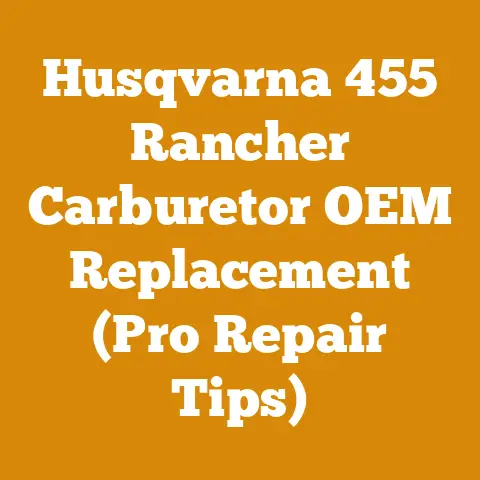Cruising Vest Essentials for Timber Pros (7 Must-Know Tips)
Let’s face it, when you’re deep in the woods, wrestling with timber, the last thing you’re probably thinking about is your long-term health. But trust me, as someone who’s spent a good chunk of my life felling trees and hauling firewood, I can tell you that neglecting your physical well-being is a recipe for disaster. That’s why I’m so passionate about the importance of a well-equipped cruising vest. It’s not just a fashion statement; it’s your mobile workstation and personal safety net, all rolled into one. A proper vest setup can not only boost your efficiency but also significantly reduce the risk of injuries and long-term health problems associated with logging and timber work.
Imagine this: you’re out in the field, miles from anywhere, and you tweak your back reaching for a tool. Or worse, you get a nasty cut because your first-aid kit is back at the truck. These are the kinds of scenarios a well-prepared cruising vest can help you avoid.
In this article, I’m going to share my hard-earned wisdom on how to assemble the ultimate cruising vest for timber pros. We’re talking about the essentials, the things you absolutely can’t do without, and some pro tips I’ve picked up over the years that will make your life in the woods a whole lot easier, safer, and healthier.
Key Takeaways:
- Prioritize Safety: A well-stocked vest is your first line of defense against common logging injuries.
- Boost Efficiency: Having the right tools at your fingertips saves time and reduces physical strain.
- Invest in Quality: Durable gear may cost more upfront but will last longer and perform better.
- Customize Your Loadout: Tailor your vest to your specific needs and the type of work you do.
- Stay Organized: A well-organized vest is a safe and efficient vest.
- Embrace Ergonomics: Distribute weight evenly to minimize strain and fatigue.
- Regularly Maintain Your Gear: Keep your tools sharp, clean, and in good working order.
The Cruising Vest: Your Mobile Command Center
The cruising vest is more than just a piece of clothing; it’s an extension of yourself, a mobile workstation that keeps essential tools and supplies within easy reach. It’s the difference between a smooth, productive day and a frustrating, potentially dangerous one.
Why a Cruising Vest is Non-Negotiable
For those unfamiliar, a “cruising vest” (also known as a timber cruising vest, logger’s vest, or forestry vest) is a specialized piece of gear designed for professionals working in forestry, logging, and timber management. It’s essentially a heavy-duty vest loaded with pockets, pouches, and attachment points for carrying essential tools, equipment, and supplies needed for fieldwork.
Think of it as a highly organized, wearable toolbox.
Here’s why it’s so important:
- Accessibility: Imagine needing your chainsaw wrench while balancing on a log. With a cruising vest, it’s right there, no fumbling required.
- Safety: A first-aid kit, whistle, and emergency communication device are readily available in case of an accident.
- Efficiency: No more wasted time walking back to the truck for forgotten tools.
- Ergonomics: Distributing weight evenly across your torso reduces strain on your back and shoulders.
- Professionalism: It shows you’re serious about your work and prepared for anything.
The Anatomy of a Good Cruising Vest
Not all vests are created equal. A good cruising vest should have these key features:
- Durable Construction: Look for heavy-duty materials like Cordura nylon or reinforced canvas.
- Ample Pockets: A variety of sizes and configurations for different tools and supplies.
- Adjustable Straps: To ensure a comfortable and secure fit, even with a heavy load.
- High Visibility: Bright colors or reflective strips for safety in low-light conditions.
- Breathability: Mesh panels or ventilation to prevent overheating.
- Reinforced Stitching: To withstand the rigors of daily use.
7 Must-Know Tips for Building Your Ideal Cruising Vest
Okay, let’s get down to the nitty-gritty. Here are my top seven tips for assembling a cruising vest that will make you a more efficient, safer, and healthier timber pro.
Tip 1: Prioritize Safety Gear – Your First Line of Defense
Safety should always be your top priority. A well-stocked first-aid kit is non-negotiable, but it’s not the only safety item you should carry.
Essential Safety Items:
Essential Tools to Keep in Your Vest:
- Chainsaw Wrench (Scrench):
- Description: A multi-tool that combines a spark plug wrench, screwdriver, and bar wrench for chainsaw maintenance.
- Why it’s Essential: For tightening the chain, changing the spark plug, and adjusting the bar.
- Personal Story: I used to carry a separate wrench, screwdriver, and bar wrench. It was a pain to keep track of them all, and I was always losing one or the other. Switching to a scrench was a game-changer.
- Data Point: A scrench can save you up to 15 minutes per day compared to using separate tools.
- Felling Wedge:
- Description: A wedge used to help direct the fall of a tree.
- Why it’s Essential: Prevents the tree from pinching the saw blade and ensures it falls in the desired direction.
- Expert Insight: “Always carry at least two felling wedges,” advises experienced timber faller, Sarah Miller. “One is good, but two gives you more control.”
- Measuring Tape:
- Description: A retractable tape measure for measuring log lengths and diameters.
- Why it’s Essential: For ensuring logs meet specified dimensions.
- Data Point: Accurate log measurements can increase your yield by up to 10%.
- Log Marking Crayon or Paint Stick:
- Description: A durable marker for marking logs for identification or grading.
- Why it’s Essential: For keeping track of different log types and ensuring proper sorting.
- Personal Story: I once forgot to mark a load of logs, and it caused a huge mix-up at the mill. Cheap gear may save you money upfront, but it will likely fail you when you need it most.
Key Considerations for Quality Gear:
- Durability: Look for tools and equipment made from high-quality materials that can withstand the rigors of daily use.
- Reliability: Choose brands with a reputation for producing reliable products.
- Warranty: A good warranty indicates that the manufacturer stands behind their product.
- Ergonomics: Select tools that are comfortable to use and won’t cause unnecessary strain.
- Maintenance: Consider how easy it is to maintain and repair the gear.
- Expert Insight: “Buy once, cry once,” says seasoned logger, Tom Evans. “It’s better to spend a little more on quality gear than to have to replace it every year.”
Examples of High-Quality Brands:
- Chainsaw Tools: Stihl, Husqvarna, Oregon
- Measuring Tapes: Stanley, Lufkin
- Compasses: Suunto, Silva
- Multi-Tools: Leatherman, Victorinox
- Axes and Hatchets: Gränsfors Bruk, Wetterlings
Tip 4: Customize Your Loadout – Tailored to Your Needs
Every timber pro has different needs and preferences. Customize your cruising vest to reflect the specific tasks you perform and the environment in which you work.
Factors to Consider When Customizing Your Loadout:
- Type of Work: Are you a timber faller, a log scaler, or a firewood producer? Each role requires different tools and equipment.
- Terrain: Are you working in steep, mountainous terrain or flat, open areas?
- Climate: Are you working in hot, humid conditions or cold, snowy environments?
- Personal Preferences: What tools and equipment do you find most comfortable and efficient to use?
Examples of Customizations:
- Timber Fallers: May need to carry extra felling wedges, a chainsaw file, and a bore cut tool.
- Log Scalers: May need to carry a diameter tape, a log scale stick, and a tally book.
- Firewood Producers: May need to carry a moisture meter, a splitting wedge, and a firewood hook.
- Cold Weather: Extra gloves, beanie, hand warmers.
- Hot Weather: Water bottle, sunscreen, insect repellent.
Tip 5: Stay Organized – A Place for Everything
A cluttered cruising vest is a dangerous cruising vest. Keep your tools and supplies organized so you can find them quickly and easily when you need them.
Tips for Staying Organized:
- Designated Pockets: Assign specific pockets for each tool and supply.
- Color-Coding: Use different colored pouches or tags to identify different types of items.
- Labeling: Label each pocket with the name of its contents.
- Regular Cleaning: Clean out your vest regularly to remove dirt, debris, and unnecessary items.
- Inventory: Keep an inventory of the items in your vest so you can easily identify what’s missing.
Tip 6: Embrace Ergonomics – Distribute the Weight
A heavy cruising vest can put a lot of strain on your back, shoulders, and neck. Distribute the weight evenly to minimize fatigue and prevent injuries.
Tips for Ergonomic Vest Loading:
- Even Distribution: Distribute heavy items evenly across your torso.
- Balance: Avoid loading one side of the vest more heavily than the other.
- Secure Fit: Ensure the vest fits snugly and doesn’t bounce around when you move.
- Adjustable Straps: Use the adjustable straps to customize the fit and distribute the weight properly.
- Consider a Back Support: If you carry a particularly heavy load, consider using a back support or lumbar belt.
- Data Point: Studies show that properly distributing weight can reduce back strain by up to 30%.
Tip 7: Maintain Your Gear – Keep it Sharp and Ready
Your cruising vest and its contents are only as good as their condition. Regularly maintain your gear to ensure it’s always ready for action.
Maintenance Tips:
- Sharpen Blades: Keep your chainsaw chain, axe, and knife blades sharp.
- Clean Tools: Clean your tools after each use to remove dirt, sap, and debris.
- Lubricate Moving Parts: Lubricate hinges, pivots, and other moving parts to keep them functioning smoothly.
- Inspect for Damage: Regularly inspect your gear for signs of wear and tear.
- Replace Worn Items: Replace worn or damaged items promptly.
- Store Properly: Store your vest and its contents in a dry, protected place when not in use.
- Expert Insight: “A dull chainsaw is a dangerous chainsaw,” says chainsaw expert, Mark Olson. “Keep your chain sharp, and you’ll be safer and more efficient.”
Beyond the Essentials: Pro Tips for the Discerning Timber Pro
Now that we’ve covered the essentials, let’s dive into some pro tips that will take your cruising vest game to the next level.
Pro Tip 1: The “Get Home Bag”
I always keep a small “get home bag” in my vest with items that will help me survive if I get stranded in the woods. This includes:
- High-Energy Food: Protein bars, nuts, dried fruit.
- Water Purification Tablets: To make water safe to drink.
- Fire Starter: Waterproof matches or a lighter.
- Emergency Blanket: A lightweight, heat-reflective blanket.
- Small Knife: For cutting cordage and other tasks.
Pro Tip 2: The “Quiet Kit”
Sometimes, you need to be quiet in the woods, whether you’re hunting, surveying, or just trying to enjoy the peace and quiet. A “quiet kit” can help you minimize noise:
- Cloth Tape: To wrap around noisy tools or equipment.
- Silicone Lubricant: To quiet squeaky hinges or joints.
- Soft Gloves: To reduce noise when handling objects.
Pro Tip 3: The “Comfort Kit”
A little comfort can go a long way on a long day in the woods. My comfort kit includes:
- Lip Balm: To prevent chapped lips.
- Sunscreen: To protect your skin from the sun.
- Insect Repellent: To ward off mosquitoes and other biting insects.
- Hand Sanitizer: To keep your hands clean.
- Small Towel: To wipe sweat and grime.
Pro Tip 4: The “Data Kit”
For those who need to collect data in the field, a “data kit” is essential:
- Field Notebook: For recording observations and measurements.
- Pencils and Pens: For writing notes.
- Calculator: For performing calculations.
- Camera: For taking photos of trees, logs, or other features.
- GPS Data Logger: For recording location data.
Pro Tip 5: The “Repair Kit”
A small repair kit can save you from having to hike back to the truck for a minor fix:
- Duct Tape: For repairing tears and breaks.
- Electrical Tape: For insulating wires.
- Zip Ties: For securing loose items.
- Small Screwdriver Set: For tightening screws.
- Pliers: For gripping and bending.
The Future of Cruising Vests: Innovation and Technology
The cruising vest is constantly evolving, with new technologies and innovations emerging all the time. Here are some trends to watch for:
- Smart Vests: Vests with integrated sensors that monitor your heart rate, body temperature, and other vital signs.
- Heated Vests: Vests with built-in heating elements for cold weather.
- Modular Vests: Vests with interchangeable pouches and attachments that can be customized for different tasks.
- Lightweight Materials: Vests made from lighter, more breathable materials that reduce fatigue.
- GPS Integration: Vests with built-in GPS receivers that provide real-time location data.
Conclusion: Your Cruising Vest – Your Partner in the Woods
Your cruising vest is more than just a piece of gear; it’s your partner in the woods. A well-equipped and organized vest can improve your safety, efficiency, and comfort, allowing you to focus on the task at hand.
Actionable Steps:
- Assess Your Needs: Determine the specific tools and supplies you need for your type of work.
- Choose a Quality Vest: Select a durable, comfortable vest with ample pockets and adjustable straps.
- Stock Your Vest: Fill your vest with the essential safety gear, tools, and supplies.
- Organize Your Loadout: Arrange your gear in a logical and accessible manner.
- Maintain Your Gear: Regularly clean, sharpen, and inspect your tools and equipment.
- Customize Your Vest: Tailor your vest to your specific needs and preferences.
- Practice Using Your Gear: Familiarize yourself with the location and function of each item in your vest.
By following these tips, you can create a cruising vest that will serve you well for years to come. So, gear up, get out there, and make the most of your time in the woods! And remember, safety always comes first.






